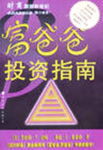富爸爸,穷爸爸(英文版)-第16章
按键盘上方向键 ← 或 → 可快速上下翻页,按键盘上的 Enter 键可回到本书目录页,按键盘上方向键 ↑ 可回到本页顶部!
————未阅读完?加入书签已便下次继续阅读!
It took our rich dad only a few minutes to explain what assets and liabilities were。
As an adult; I have difficulty explaining it to other adults。 Why? Because adults are smarter。 In most cases; the simplicity of the idea escapes most adults because they have been educated differently。 They have been educated by other educated professionals; such as bankers; accountants; real estate agents; financial planners; and so forth。 The difficulty es in asking adults to unlearn; or bee children again。 An intelligent adult often feels it is demeaning to pay attention to simplistic definitions。
Rich dad believed in the KISS principle…〃Keep It Simple Stupid〃…so he kept it simple for two young boys; and that made the financial foundation strong。
So what causes the confusion? Or how could something so simple be so screwed up? Why would someone buy an asset that was really a liability。 The answer is found in basic education。
We focus on the word 〃literacy〃 and not 〃financial literacy。〃 What defines something to be an asset; or something to be a liability are not words。 In fact; if you really want to be confused; look up the words 〃asset〃 and 〃liability〃 in the dictionary。 I know the definition may sound good to a trained accountant; but for the average person it makes no sense。 But we adults are often too proud to admit that something does not make sense。
As young boys; rich dad said; 〃What defines an asset is not words but numbers。 And if you cannot read the numbers; you cannot tell an asset from a hole in the ground。〃
〃In accounting;〃 rich dad would say; 〃it's not the numbers; but what the numbers are telling you。 It's just like words。 It's not the words; but the story the words are telling you。
Many people read; but do not understand much。 It's called reading prehension。 And we all have different abilities when it es to reading prehension。 For example; I recently bought a new VCR。 It came with an instruction book that explained how to program the VCR。 All I wanted to do was record my favorite TV show on Friday night。 I nearly went crazy trying to read the manual。 Nothing in my world is more plex than learning how to program my VCR。 I could read the words; but I understood nothing。 I get an 〃A〃 for recognizing the words。 I get an 〃F〃 for prehension。 And so it is with financial statements for most people。
〃If you want to be rich; you've got to read and understand numbers。〃 If I heard that once; I heard it a thousand times from my rich dad。 And I also heard; 〃The rich acquire assets and the poor and middle class acquire liabilities。〃
Here is how to tell the difference between an asset and a liability。 Most accountants and financial professionals do agree with the definitions; but these simple drawings were the start of strong financial foundations for two young boys。
To teach pre?teen boys; rich dad kept everything simple; using as many pictures as possible; as few words as possible; and no numbers for years。
〃This is the Cash Flow pattern of an asset。〃
The above box is an Ine Statement; often called a Profit and Loss Statement。 It measures ine and expenses。 Money in and money out。 The bottom diagram is the Balance Sheet。 It is called that because it is
supposed to balance assets against liabilities。 Many financial novices don't know the relationship between the Ine Statement and the Balance Sheet。 That relationship is vital to understand。
The primary cause of financial struggle is simply not knowing the difference between an asset and a liability。 The cause of the confusion is found in the definition of the two words。 If you want a lesson in confusion; simply look up the words 〃asset〃 and 〃liability〃 in the dictionary。
Now it may make sense to trained accountants; but to the average person; it may as well be written in Mandarin。 You read the words in the definition; but true prehension is difficult。
So as I said earlier; my rich dad simply told two young boys that 〃assets put money in your pocket。〃 Nice; simple and usable。
〃This is Cash Flow pattern of a liability。〃
Now that assets and liabilities have been defined through pictures; it may be easier to understand my definitions in words。
An asset is something that puts money in my pocket。
A liability is something that takes money out of my pocket。
This is really all you need to know。 If you want to be rich; simply spend your life buying assets。 If you want to be poor or middle class; spend your life buying liabilities。 It's not knowing the difference that causes most of the financial struggle in the real world。
Illiteracy; both in words and numbers; is the foundation of financial struggle。 If people are having difficulties financially; there is something that they cannot read; either in numbers or words。 Something is misunderstood。 The rich are rich because they are more literate in different areas than people who struggle financially。 So if you want to be rich and maintain your wealth; it's important to be financially literate; in words as well as numbers。
The arrows in the diagrams represent the flow of cash; or 〃cash flow。〃 Numbers alone really mean little。 Just as words alone mean little。 It's the story that counts。 In financial reporting; reading numbers is looking for the plot; the story。 The story of where the cash is flowing。 In 80 percent of most families; the financial story is a story of working hard in an effort to get ahead。 Not because they don't make money。 But because they spend their lives buying liabilities instead of assets。
For instance; this is the cash flow pattern of a poor person; or a young person still at home:
Job (provides ine)…》 Expenses(Taxes Food Rent Clothes Fun Transportation)
Asset (none)
Liability (none)
This is the cash flow pattern of a person in the middle class:
Job (provides ine)…》 Expenses(Taxes Food Mortgage Clothes Fun Transportation)
Asset (none)
Liability (Mortgage Consumer loans Credit Cards)
This is the cash flow pattern of a wealthy person:
Assets(stocks bonds notes real estate intellectual property)…》ine (dividends interest rental ine royalties)
Liabilities (none)
All of these diagrams were obviously oversimplified。 Everyone has living expenses; the need for food; shelter and clothing。
The diagrams show the flow of cash through a poor; middle class or wealthy person's life。 It is the cash flow that tells the story。 It is the story of how a person handles their money; what they do after they get the money in their hand。
The reason I started with the story of the richest men in America is to illustrate the flaw in the thinking of so many people。 The flaw is that money will solve all problems。 That is why I cringe whenever 1 hear people ask me how to get rich quicker。 Or where do they start? I often hear; 〃I'm in debt so I need lo make more money。〃
But more money will often not solve the problem; in fact; it may actually accelerate the problem。 Money often makes obvious our tragic human flaws。 Money often puts a spotlight on what we do not know。 That is why; all too often; a person who es into a sudden windfall of cash…let's say an inheritance; a pay raise or lottery winnings…soon returns to the same financial mess; if not worse than the mess they were in before they received the m





